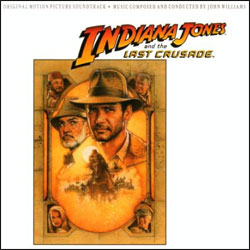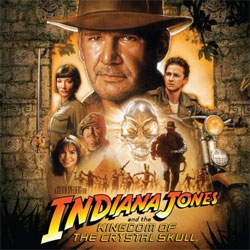| 
Disc 3: Indiana Jones and the Last Crusade
After Temple, Indiana Jones and the Last Crusade (1989) can sound downright leisurely. Much of the score—the part focusing on Indy’s relationship with his father and the spiritual nature of the Grail Quest—is subdued and introspective, with Williams working in a distinctly English idiom. But there’s plenty of action and old-fashioned high-stakes drama on hand here. Indy’s theme returns in force, and the score is graced with the usual collection of top-notch set-pieces. Williams goes further, however, adding more new recurring themes into the mix than in any of his other Indy scores. There’s the Spanish-flavored motif for the Cross of Coronado, and the sinister muted trumpets of the villain known only as “Panama Hat.” There’s a theme for the Holy Grail and a theme for the Grail Knights. Indy’s father, Henry Jones Sr. has a theme; father and son together have at least two themes—one for bonding, one for adventuring. The film’s not-quite-love-interest doesn’t merit a proper melody this time around, but the Nazis get an appropriately wicked march. Even Hitler gets a minor motif (hear it at the beginning of “To the Blimp”). As a whole, the score is not quite as lean and well-balanced as Raiders, nor as dazzling and dynamic as Temple, but its rich character makes it a common fan-favorite. It is unquestionably one of the great scores of the 1980s.
What’s new? Quite a bit, all of it good: the second half of “Indy’s Very First Adventure” and the subsequent “Boat Scene”—which means that Panama Hat is now present and accounted for; the short but spellbinding “Journey to Austria,” and Indy’s intrusion into Castle Brunwald; Elsa’s farewell kiss; and father and son’s escape from the burning room. Finally, and most notably, the thrilling middle portion of the tank sequence gets its first official release (although it has not been integrated between parts one and three, which are still merged as “Belly of the Steel Beast,” as they were on the original album).
What’s on Disc 5? Last Crusade gets the most representation on Disc 5. Indy exploring his father’s ransacked house is here. “Marcus Is Captured” is strangely combined with “To Berlin,” although it’s nice to have both cues at last (the former was severely truncated in the film, and until now has only been known from horrible-sounding bootlegs). “To the Blimp” is my personal favorite of the Crusade cues on Disc 5, featuring as it does Williams’ unused music for Indy’s face-to-face encounter with Hitler. “The Blimp Turns Around” features a gorgeous, if brief, variation on the Grail theme. (A nit-picky aside: The airship in question is a Zeppelin, not a Blimp. In his original manuscript, Williams uses the term “dirigible,” which is technically accurate; blimp, however, is not.) “Death of Kazim” is a particularly nice surprise, as it was cut up with inserts in the finished film. “Wrong Choice, Right Choice” finally gives us the music for the film’s climax, as Donovan is destroyed and Indy heals his father.
What’s missing? Indy being picked up by Donovan’s men at the beginning of the film, for one, followed by the score’s first appearance of the Grail theme; breaking through the library floor and the initial descent into the catacombs, with a sly quote of the Ark theme from Raiders; Indy’s first conversation with his father and Elsa’s betrayal; all of the source music, including “Der Konnigratzer” from the Nazi rally (not by Williams) and two pieces for Iskenderun; numerous brief inserts of Indy’s theme and the Nazi theme; finally, the music where Indy’s father is shot, followed by the real “The Penitent Man Will Pass” (the track with that title on the album actually underscores trials number two and three). A few overdubs are missing (a calliope in “Indy’s Very First Adventure” and additional mandolins in “Escape From Venice”), as well as two alternate cue beginnings (for the newly released portion of “Indy’s Very First Adventure” and the intro to “Escape From Venice”), but these are minor quibbles.

Disc 4: Indiana Jones and the Crystal Skull
As regards Indiana Jones and the Kingdom of the Crystal Skull, I am not among the score’s detractors. I find the new material—a sultry theme for femme fatale Irina Spalko; a creepy and far-ranging theme for the Skull (with a great B-section, to boot); Mutt’s charged orchestral runs and variation on the main Indy theme (the fourth note drops an octave, as heard in “The Jungle Chase”); and the versatile Russian theme—to be invigorating and worthy of admittance to the Indy canon. The disc is full of fine set-pieces such as “A Whirl Through Academe”
(check out the witty references to the traditional German student songs well-known from Brahms’ “Academic Festival Overture”) and “The Snake Pit,” and gains depth with multiple listens.
What’s new/What’s on Disc 5? Absolutely nothing. Disc 4 is identical to the CD that came out at the time of the film’s release, and according to Bouzereau no expansion was ever planned. Fans would do well, however, to check out the film’s 2-disc DVD. Glimpses of unreleased cues can be heard on various menus, and the VFX reels on Disc 2 feature many minutes of exciting unreleased music—albeit heavily edited in places.
What’s missing? As album presentations go, Kingdom is average, playing fast and loose with the film’s chronology and skewing heavily towards the skull-oriented cues. Much of the score’s best action material is omitted, and you won’t hear a note of Marion’s theme between the album-opening “Raiders March” and the album-ending “Finale.” Approximately a third or more of the music Williams wrote for the film remains unreleased, and its inclusion would go a long way towards balancing things out. Cross your fingers and hope that an expanded album for this one doesn’t take almost 20 years!
Incidentally, while the album contains four “concert cues,” Williams has been performing two new concert pieces in recent months: a new arrangement of “Irina’s Theme,” and a first-ever concert version of “Marion’s Theme,” featuring a new bridge section. These were presumably written after the film’s recording sessions, and so were not available for inclusion on this set. Hopefully they will see an official release in the not-too-distant future, perhaps as part of an Erich Kunzel, City of Prague or (ideally) Boston Pops compilation.
|










